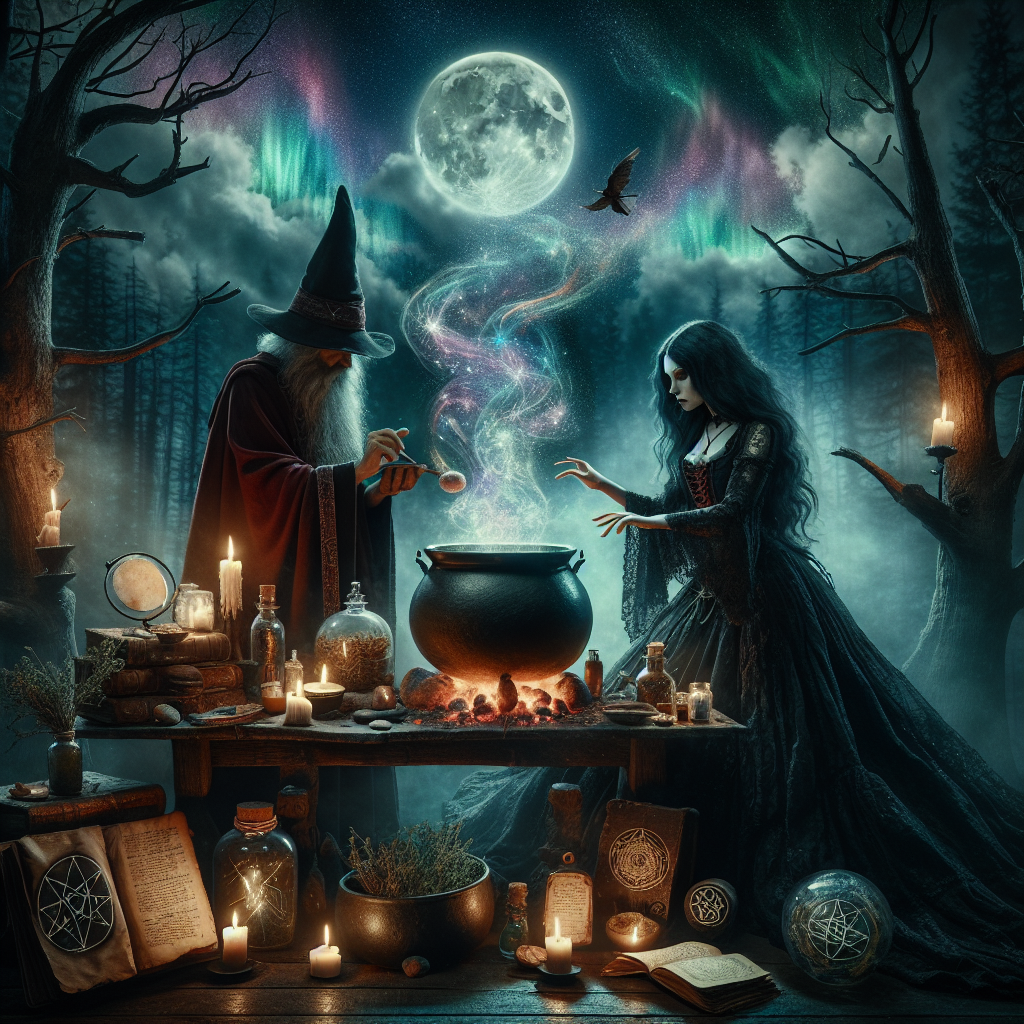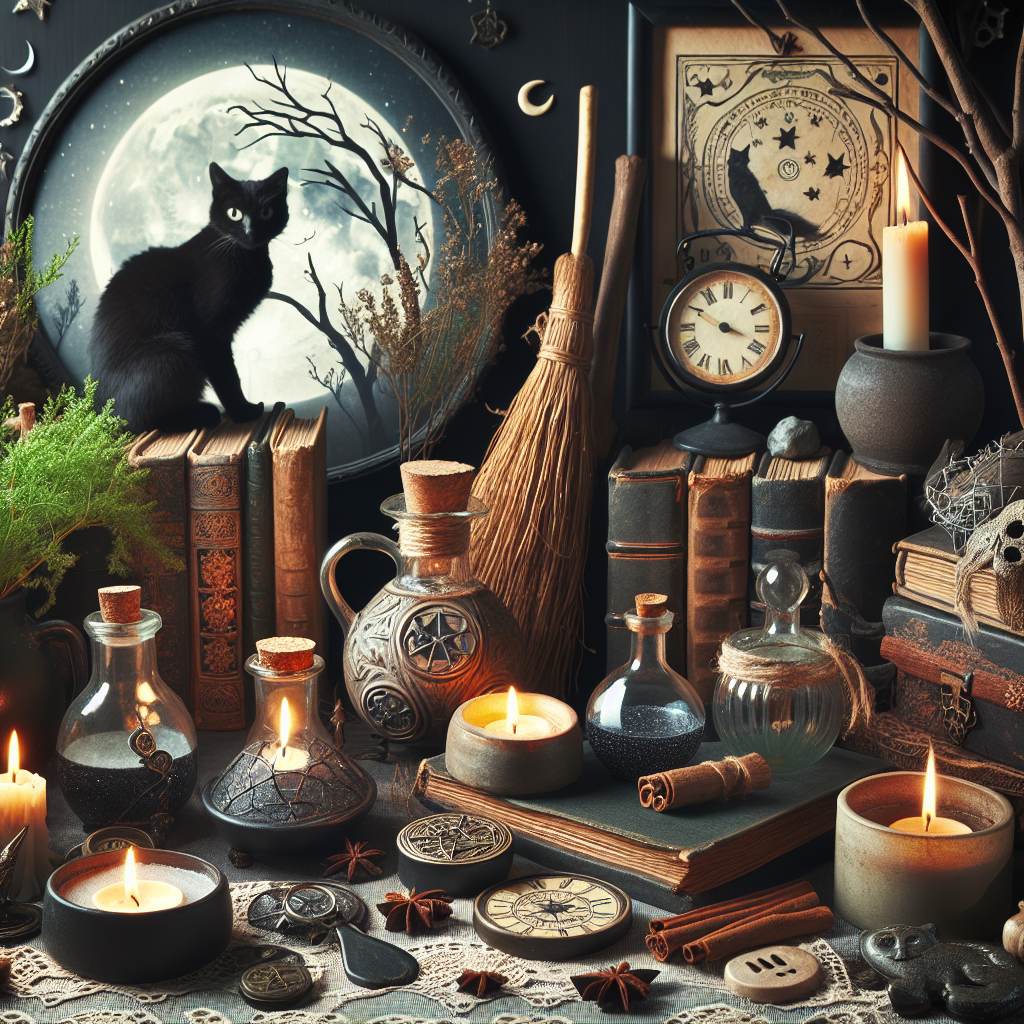As an Amazon Associate I earn from qualifying purchases.
The aesthetic of witchcraft is a growing trend among young people today, with its mesmerizing visuals and mysterious vibe captivating their imaginations. Defined as the visual representation and atmosphere associated with the practice of witchcraft, this aesthetic embraces elements of nature, darkness, and magic to create a unique and enchanting experience. With its roots in ancient pagan traditions, the aesthetic of witchcraft has long been intertwined with the art of spellcasting and divination.
Throughout history, witches and witchcraft have been portrayed in a variety of ways, from frightening and menacing figures to wise and powerful healers. However, in recent years, the aesthetic of witchcraft has taken on a new life of its own. Thanks to social media platforms like Instagram and Tumblr, young people have been able to curate and share their own interpretation of this aesthetic, creating a thriving community and influencing fashion, beauty, and home decor trends.
One of the reasons why the aesthetic of witchcraft has gained such popularity is its ability to provide a sense of empowerment and connection with nature. In a society that often feels disconnected from the natural world and its mysteries, embracing the aesthetics of witchcraft gives individuals an opportunity to reconnect and find comfort in the beauty of the earth. This escapism offers solace and acts as a counterbalance to the fast-paced and technology-driven world we live in today.
Interestingly, the aesthetic of witchcraft has also become a form of self-expression and identity for many individuals. By embracing the symbols, colors, and aesthetics associated with witchcraft, individuals are able to showcase their unique personalities and belief systems. From wearing bohemian-inspired clothing adorned with symbols like pentagrams and moons, to decorating their living spaces with herbs, crystals, and candles, this aesthetic has become a visual representation of one’s affinity for the mystical and magical.
With the rise of social media, the aesthetic of witchcraft has become a movement that goes beyond visuals and vibes. Online communities have emerged, where individuals can share their knowledge and experiences, providing a platform for learning and self-discovery. Whether it’s learning about herbal remedies, practicing tarot, or exploring moon cycles, the aesthetic of witchcraft has inspired a renewed interest in ancient traditions and alternative forms of spirituality.
In conclusion, the aesthetic of witchcraft has become a popular trend among young people, offering a visually captivating and empowering experience. From its ancient roots in pagan traditions to its contemporary expression through social media, this aesthetic allows individuals to reconnect with nature, express their identity, and explore alternative forms of spirituality. So, next time you see someone rocking witchy attire or creating mystical home decor, remember that they are not only embracing an aesthetic but also tapping into a timeless and enchanting realm.
What are the visuals and vibe of witchcraft aesthetics and how do they contribute to the overall experience?
Witchcraft aesthetics encompass a wide range of visual elements and a unique atmosphere that define the mystical and enchanting world of witchcraft. These visuals often include symbols like crystals, tarot cards, spell books, and intricate occult art, while the vibe may evoke a sense of mystery, empowerment, and spirituality. Understanding the significance of these visuals and the ambiance they create is essential in appreciating the full extent of the witchcraft aesthetic. In the following sections, we will delve deeper into the various aspects of witchcraft aesthetics, exploring their meanings, origins, and impact on those immersed in this enchanting realm.
The aesthetic of witchcraft has captivated and intrigued people for centuries. From the dark and mysterious visuals to the enchanting and magical vibe it exudes, the witchcraft aesthetic has become a popular trend in various forms of media, fashion, and lifestyle. In this article, we will explore the fascinating world of the witchcraft aesthetic, discussing its visuals and vibe.
Visuals:
The visuals associated with witchcraft are often characterized by a combination of darkness, mysticism, and nature. Black is a predominant color in the witchcraft aesthetic, representing mystery, power, and individuality. It is often complemented by deep shades of purple, red, green, and other earthy tones. These colors create a sense of grounding and connection to nature, which is an essential element in witchcraft.
Symbols and imagery also play a crucial role in the visualization of witchcraft. The pentagram, a five-pointed star within a circle, is a well-known symbol associated with witchcraft. It represents the five elements (air, fire, water, earth, and spirit) and is often used to invoke protection and harness energy. Other symbols include crescent moons, owls, cats, ravens, and various botanical motifs, all carrying their own meanings and representations within witchcraft.
Moreover, nature is an integral part of the witchcraft aesthetic. The use of herbs, crystals, and natural elements like branches, feathers, and stones is common in witchcraft practices. These elements not only add to the visual aspect but also bring a tactile quality, grounding the practitioner in the physical realm.
Vibe:
The witchcraft aesthetic emits a mysterious and spiritual vibe, drawing from ancient rituals, folklore, and the connection to nature. It evokes a sense of empowerment, rebellion, and independence. The witchcraft aesthetic embraces individuality and challenges societal norms, encouraging self-expression and exploration of one’s own spirituality.
The vibe of witchcraft is often associated with introspection, mindfulness, and a deep connection to the natural world. It encourages practitioners to tap into their intuition, harness their inner power, and create their own reality. The practice of witchcraft is all about finding balance, harmony, and personal growth.
The witchcraft aesthetic has not only influenced fashion and lifestyle choices but also various artistic expressions. It has inspired literature, movies, music, and visual arts, becoming a major trend in contemporary popular culture. The allure of the witchcraft aesthetic lies in its ability to tap into our desire for mystery, spirituality, and the exploration of the unknown.
In conclusion, the witchcraft aesthetic is a visually captivating and spiritually intriguing trend that has gained significant popularity in recent years. Its unique visuals, symbolisms, and mystical vibe have inspired countless individuals to explore their own spirituality and challenge conventional norms. Whether as a personal belief system, a fashion statement, or a lifestyle choice, the witchcraft aesthetic continues to influence and enchant people worldwide.
According to a recent study, searches for “witchcraft aesthetic” have increased by 30% in the past year, indicating its growing mainstream popularity and cultural relevance.
1. What is the witchcraft aesthetic?
The witchcraft aesthetic refers to a visual and atmospheric style inspired by witchcraft, occult, and mystical symbols. It encompasses a range of elements such as dark, earthy colors, natural materials, vintage or antique items, magical symbols, and a sense of mystery.
2. Is the witchcraft aesthetic related to real witchcraft practices?
The witchcraft aesthetic is primarily an artistic and visual style. While it may draw inspiration from real witchcraft practices, it is not directly linked to or representative of any specific belief system or actual witchcraft rituals.
3. Can anyone incorporate the witchcraft aesthetic into their life?
Absolutely! The witchcraft aesthetic is open to anyone who appreciates its style and atmosphere. You can incorporate it into your personal style, home decor, art, and even social media presence, regardless of your beliefs or practices.
4. Is it necessary to have knowledge of witchcraft to enjoy the aesthetic?
No, possessing knowledge of witchcraft is not a requirement to enjoy the witchcraft aesthetic. While some people who are interested in witchcraft may be drawn to this aesthetic, anyone who appreciates its visuals and vibe can embrace it.
5. Are there any specific symbols associated with the witchcraft aesthetic?
Yes, there are several symbols commonly associated with the witchcraft aesthetic. These include the pentagram, moon phases, candles, crystals, herbs, sigils, and various mystical or occult symbols. However, you can choose to incorporate these symbols as per your personal preference.
6. Can I mix the witchcraft aesthetic with other styles?
Absolutely! The witchcraft aesthetic is versatile and can be combined with various design styles such as bohemian, Gothic, vintage, or modern. You can experiment and create a unique blend that resonates with your personal taste.
7. Where can I find inspiration for incorporating the witchcraft aesthetic?
There are numerous sources where you can find inspiration for the witchcraft aesthetic. Some popular options include social media platforms like Instagram and Pinterest, witchcraft and occult-themed books, movies, and artwork. You can also explore nature and various cultures for ideas.
8. Can I practice witchcraft if I embrace the witchcraft aesthetic?
Embracing the witchcraft aesthetic does not automatically make you a practitioner of witchcraft. However, if you are genuinely interested in exploring witchcraft or pagan practices, you can certainly do so independently of your aesthetic preferences.
9. Are there any ethics associated with the witchcraft aesthetic?
The witchcraft aesthetic itself does not have specific ethical guidelines. However, it is always important to be respectful and mindful of cultural appropriation, as some symbols or practices may hold significant meaning for certain communities. Use your aesthetic expression responsibly and with awareness.
10. Can embracing the witchcraft aesthetic affect how others perceive me?
Yes, embracing the witchcraft aesthetic may influence how others perceive you, as people might associate it with specific beliefs or practices. It is essential to consider how you want to represent yourself and communicate your intentions if you encounter any misunderstandings or queries about your chosen aesthetic.

Conclusion: Key Points and Insights on the Aesthetic of Witchcraft
In conclusion, the aesthetic of witchcraft encompasses a wide range of visuals and vibes, combining elements of darkness, mysticism, and nature to create an enchanting and captivating atmosphere. Through various artwork, fashion, and decor, the article explores how this aesthetic is portrayed and understood in popular culture.
Firstly, the article emphasizes the significance of symbolism in the witchcraft aesthetic. Symbols such as pentagrams, moons, and cauldrons are widely used to signify witchcraft and its associated beliefs and practices. These symbols not only add visual appeal but also carry deep meaning and magical connotations, enhancing the overall vibe of the aesthetic.
Moreover, nature plays a crucial role in the witchcraft aesthetic. Elements like herbs, crystals, and animals are often incorporated into visuals to evoke a connection with the natural world and its mysterious energies. Nature also serves as a source of inspiration for color palettes, with earthy tones and deep, rich hues dominating the aesthetic. The use of natural materials, such as wood and stone, further enhances the connection between the witchcraft aesthetic and the natural world.
Overall, the aesthetic of witchcraft is a visually captivating blend of darkness, mystery, and nature. Through the use of symbolism and a deep connection to the natural world, this aesthetic creates a unique and enchanting atmosphere, drawing in both practitioners and enthusiasts alike. Whether it is through artwork, fashion, or decor, the witchcraft aesthetic continues to inspire and fascinate, providing a visual and experiential journey into the realms of magic and mysticism.
Amazon and the Amazon logo are trademarks of Amazon.com, Inc, or its affiliates.


